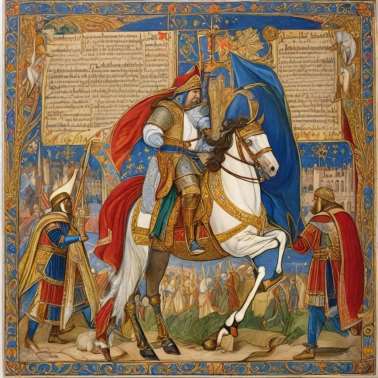Chapter Nineteen
Order of Knights of St. Thomas of Canterbury -
https://www.okstc.org/
The Order of Knights of St. Thomas of Canterbury was established in 2022
with the inspiration of the historical Hospitallers of Saint Thomas of Canterbury at Acre. This noble order seamlessly blends traditional chivalric values with a modern approach to knighthood, focusing on charitable tasks and maintaining the ethos of the original Hospitaller Order. The organization is a non-profit dedicated to charitable good deeds and embodies timeless ideals of honour, duty, and compassion, in line with the chivalry code of honour.
Membership in this knightly order is inclusive and open to individuals from all backgrounds, regardless of religion, faith, disabilities, gender, race, or sexual orientation. The members are chosen for their unwavering commitment to values like compassion, honesty, and integrity, forming a beacon of goodness in the United Kingdom. The order proudly carries forward the legacy of the English Crusaders and is affiliated with the Royal Society of Saint George, advocating for humanitarian aid, protection, peacebuilding, and sustainable development.
The moral code of conduct of the Order of Knights of St. Thomas of Canterbury is based on the chivalry code of honour, emphasizing justice, fairness, and equality. The organization boldly challenges discriminatory practices and strives for a society that reflects these values. The order is deeply committed to promoting British heritage, chivalric, and Christian ideals, while also working to support the most vulnerable in society. Additionally, 30% of the membership fee or merchandise price goes to various good causes in the UK, contributing to the organization’s dedication to charitable work. To date 19
charities have been supported and £11090 raised and donated to good causes.
The command council of the Order of Knights of St. Thomas of Canterbury is responsible for guiding the
organization and ensuring
that its mission and
values are upheld. The
council plays a key role in
decision-making,
governance, and strategic
direction,
working
to
achieve the charitable
goals and maintain the
noble traditions of the
order.
80
Endnote
I have always had a keen interest in history, a lot of this stems from looking into my family’s ancestry. Of particular interest is my mother’s maiden name being Nunney, at first all I knew was it being a village with an impressive castle in Somerset. I found a book on the surname Nunney, which showed that in the early 1900s when the most Nunney's were recorded, nearly all were in Somerset except a small group in Derbyshire, my great grandparents and siblings. Early 2000 there were only four Nunney's out of Somerset, all in Sheffield being my Uncle David, his two sons and a Grandson. Spurred on by this information, I wanted to trace my ancestry with the intent working my way back to ancestors actually residing in the village of Nunney.
It's taken some time to achieve, but on eventually getting my family back to Somerset I was then able to use the local historical/family history group’s archives to continue my research. Their brilliant records enabled me to go back all the way to the Norman Conquest of 1066, with the arrival of Guillaume (William) de La Mare – who became Chief of the lands in the county Gloucestershire (William Earl of Gloucester was the King's cousin) and Herefordshire, by 1086 A.D. also Wiltshire. The Lord still had a Castle and Estates in France including Pont Audemer in Normandy. Sometimes he was called William FitzNorman and was the scion of that family name.
The De La Mare, that most interests me is William de La Mare who was an English Franciscan theologian from Lincoln, who assisted in the escape of Thomas Becket into France and the safety of a Franciscan Priory to await news from the Pope. On Thomas's death William did become a founder knight of the Order of St. Thomas of Acre and survived in old age the final siege of Acre, escaping to Cyprus and then Malta. In his final days he became a knight of the order of St. Lazarus who took over many of the Knights of St. Thomas's holdings.
Moving forward a couple of hundred years and we then have Sir John Delamare (c. 1320-1383) our main ancestor of the court of King Edward III and was granted permission to turn his manor house at Nunney into Nunney Castle in 1373. It is interesting many say that it was modelled on the Bastille, but I have seen early images of Pont Audemer in Normandy, and it resembles that more. The model and design of this small fort was also a template for small strong holds built in the holy land especially that in Damascus.
Sir John Delamare served as High Sheriff of Wiltshire in 1374 and later High Sheriff of Somerset and Dorset in 1377. It is his niece Eleanor Delamere, who inherited his estates whom we descend from when on marriage she took the name of Nunney.
It is interesting also that the name FitzNorman was also called at times FitzStephen. It is a William FitzStephen to whom we have the earliest chronical of the life of St. Thomas Becket.
81

The convergence of the Nunney and de la Mare lineages encapsulates a narrative rich in heritage and historical significance. William de la Mare’s pivotal role in the preservation of the Order of St. Thomas of Acre and his family’s enduring impact on medieval history serve as a testament to the intertwined legacies of the Nunney and de la Mare families, solidifying their place in the chronicles of nobility and faith.
Illuminated manuscript depicting an image of William da La Mare believe to at in Holy Land, probably Acre.
The British Library – Illuminated manuscripts collection.
82
Citations




